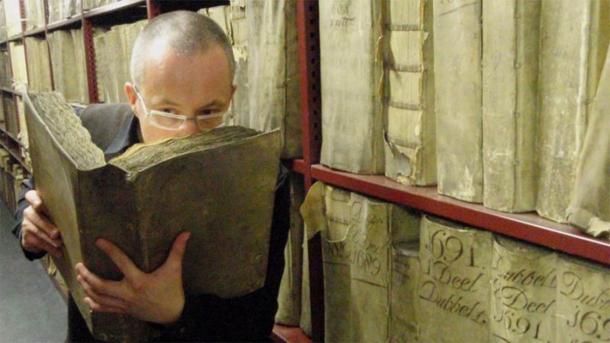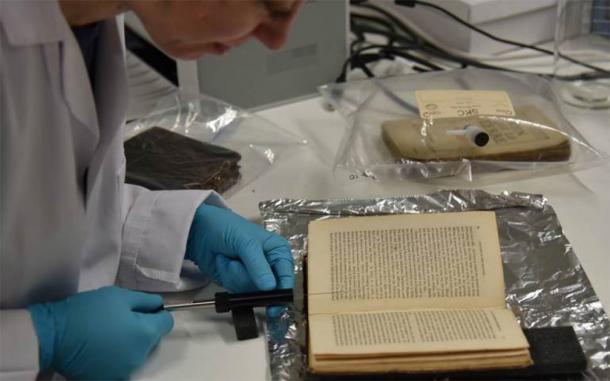An artificial intelligence (AI) robot is set to scan historical texts and paintings to recreate now extinct scents and smells. In the 2006 movie Perfume: The Story of a Murderer , directed by Tom Tykwer, it was said that “odors have a power of persuasion stronger than that of words, appearances, emotions, or will. This is now the underlying belief of the international team of researchers who are setting out to understand the smellscapes of the ancient world. And to do this, they’re building an artificial intelligence archaeologist with an electronic nose.

An AI robot will be used to scan historic texts and paintings as parte of the Odeuropa project, which aims to create a smell encyclopedia and recreate smells of the past. In the image Professor Matija Strlic smells an ancient text in the National Archives of The Netherlands. (Matija Strlic / Odeuropa)
Get Ready for the Smell of History
The EU Horizon 2020 program recently awarded a €2.8M Euros ($3.32 million US dollars) grant for project Odeuropa , that intends to use AI to identify references to smells in historical texts dating back to 16th century. And with the new scent database a “smell-encyclopedia” will be complied and published online.
Project Odeuropa is a collaborative effort with researchers from UCL, Anglia Ruskin University and the Royal Netherlands Academy of Arts and Sciences . The grant will allow for the creation of artificial intelligence to scan history books that are crammed with evidence of smells and bring them back to life. Recreating ancient aromas, the project aims to determine how places and people might have smelled in the past.
The new encyclopedia of scents will feature a biography of every individual odor, including from what, and where, it was made. This new information will be made available to chemists and perfumers all over the world who will then recreate modern versions of the ancient smells.

According to Dr. Sara Tonelli, of Fondazione Bruno Kessler (FDK), the team will use artificial intelligence to research different smells and find information about smell in ancient texts. ( Odeuropa)
Scanning History’s Multimedia Records
According to a report in the Daily Mail , Lizie Marx, a PhD student at the Rijksmuseum in Amsterdam, said the artificial intelligence will “scour old texts for descriptions of smells in seven languages.” To create the new aroma database, detailed descriptions of odors, and their contexts, will be gathered. The artificial intelligence will also scan for items relating to aromatics in ancient paintings and imagery.
Dr. Sara Tonelli of Fondazione Bruno Kessler (FDK) told the Daily Mail that the team of researchers intend to analyze, for example, “the role of industrial smells.” In this instance the scientists expect to find a lot of mentions in texts “by Italian futurists for example the smell of motor oil.” According to an article in The Guardian , Dr. William Tullett of Anglia Ruskin University in Cambridge said tobacco was really “an essential smell in European history and heritage.” With what he describes as “a hot, smoky, pungent smell,” it holds data about links to histories of sociability, of trade and health, and colonization.
Tobacco was first introduced to Europeans soon after 1492 AD when Columbus landed in the Americas. The great explorer wrote in his diary, on October 15th 1492 AD, that he “observed an Indian sailing in a canoe with water, food, and tobacco leaves.”
Resurrecting the Emotions of History
Dr. Tullett added that the new study will also include discussions of particular types of “ noses” from the past. This will help illustrate “the kinds of people for whom smell was significant, and what smell meant to them.” The new online encyclopedia of European smells will include detailed biographies of the odors, but the results of the greater research project will offer new insights into the places, and emotions associated with each scent. According to an SIRC report, the perception of smell consists not only of the sensation of the odors themselves, but also of “the experiences and emotions associated with these sensations.”
Like music can take us back to a single event, place or person twenty years ago, so too can smells evoke strong emotional reactions. Surveys on how people respond to different odors show that many of our olfactory likes and dislikes are based purely on emotional associations. Considering this, Tullett has said that the research will penetrate into the use of medicinal herbs , such as “ rosemary, which was applied in the 17th century to protect against plague, and again in the 18th and 19th centuries as an antidote to fits and fainting.”
When the online database is published, the public will have access to broad strokes of olfactory heritage, while the raw information will be offered to chemists and perfumers to create modern-day versions of ancient smells. Looking forward, these newly created scents could be featured in museum exhibitions , thus adding a new dimension to historical settings and potentially untapping an unexplored range of emotions within us all.
Top image: Odeuropa will publish a smell encyclopedia, after research into historic smells. This is a groundbreaking sensory archaeology project which has been awarded a grant by the EU Horizon 2020 program. Source: Wellcome Trust / CC BY 4.0
By Ashley Cowie
Related posts:
Views: 0
 RSS Feed
RSS Feed

















 November 19th, 2020
November 19th, 2020  Awake Goy
Awake Goy  Posted in
Posted in  Tags:
Tags: 
















